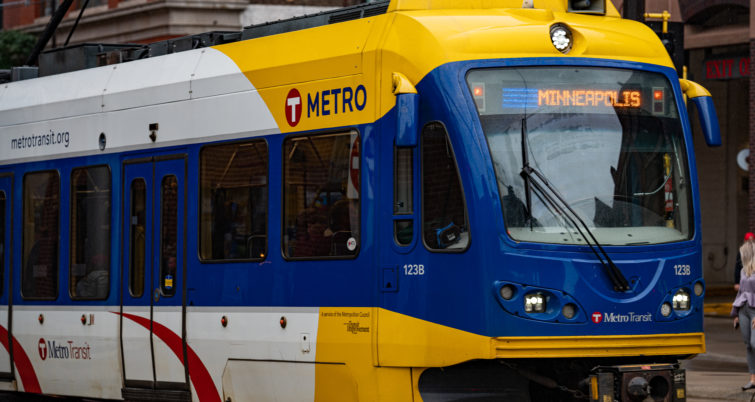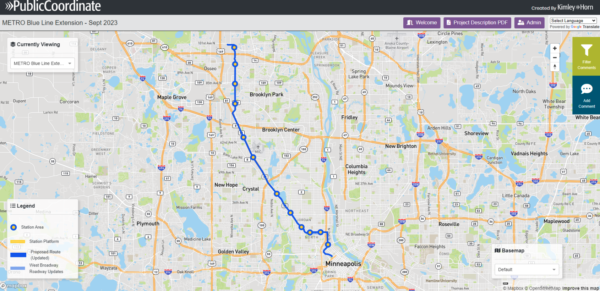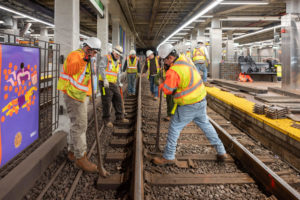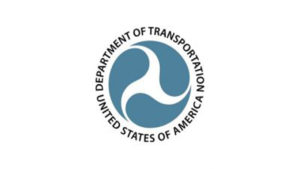Early Ridership and Cost Data Indicate Blue Line Extension ‘Competitive’ for Federal Funding
Written by Jennifer McLawhorn, Managing Editor
HENNEPIN COUNTY, Minn. – Metropolitan Council has released early cost and ridership data based on 2019 and 2022 ridership survey data that indicates the Blue Line Extension is ‘competitive’ for federal funding.
The Metropolitan Council announced that early estimates of ridership and cost ranges for its METRO Blue Line Extension indicate it continues to be eligible for federal funding through the FTA’s New Starts program.
According to the USDOT, there are three categories under the Capital Investment Grants (CIG) program;
- Small Starts: projects less than $400 million in total project cost seeking CIG funding of less than $150 million
- New Starts: projects with total costs of $400 million or more and are seeking CIG funding of more than $150 million
- Core Capacity: projects in an existing fixed guideway corridor that is at capacity today or will be in 10 years, where the project will increase the capacity of the corridor by at least 10 percent.
The Blue Line Extension will extend the existing Blue Line 13.4 miles north and connect communities in North Minneapolis, Robbinsdale, Crystal, and Brooklyn Park to the light rail network. It’s expected to bring the daily ridership to the more than 30,000 by adding 11,500 to 13,00 daily rides. According to the release, as much as 50% of these new riders are expected to come from households that do not own a car and rely on public transit.
Met Council Member Reva Chamblis said, “Providing efficient, reliable, all-day transit service will add mobility that doesn’t exist today for many residents along the Blue Line Extension corridor.” Met Council reports that systemwide transit ridership in the area grew 16% last year, and light rail ridership jumped 19%, bringing ridership back to 60% of pre-pandemic levels, with these numbers expected to increase.
These ridership ranges were forecasted using a new federal forecasting model, Simplified Trips on Project Software (STOPS). It incorporates a blend of 2019 and 2022 ridership survey data. Met Council says existing “Twin Cities light rail projects have exceeded previous early model estimates by 20% to 30%.” Project staff will update the estimates this summer as it is expecting a revised STOPS model from the FTA this spring that will include 2023 ridership data.
Hennepin County Commissioner Irene Fernando said, “These early figures show light rail is the right service for this corridor,” said Hennepin County Commissioner Irene Fernando. “But ridership isn’t just about the number of people riding. It’s also about who we are serving. This is a generational equity investment in communities of color that have historically been underinvested in. It will guarantee premium transit service in communities of color who rely on transit every day to get to work, school, healthcare, family, and opportunities. These communities have experienced a history of underinvestment and racial disparities stemming from generations of systemic racism. They deserve the same level of investment as others benefitting from light rail investments in our region.”

To construct the Blue Line Extension, current projections show a base const at $2.2 billion. The federal government requires projects to add contingency costs between 35% and 45% to account for potential costs associated with unknown risks and conditions in an early design phase. This would bring the preliminary total cost between $2.9 billion and $3.2 billion. Met Council says this preliminary range is consistent with national inflation trends and rising construction costs.
Now, the Met Council will begin reviewing and discussing this information with the Corridor Management Committee and committees along the line. In the summer, “each of the cities will review project plans in a municipal consent process and the Met Council will use its Transitway Advancement Policy for further analysis.” As well, each city along the proposed line will review project plans in a municipal consent process. This approval is required for the project to move forward under Minnesota law.
These early ridership and cost estimates will be peer reviewed and shared with the FTA. Met Council says the updated estimates will be officially submitted to the FTA for a formal project rating in early 2025. Over this summer, project staff will also release a draft environmental study “that will clearly identify opportunities of the project, as well as impacts and possible strategies to avoid, minimize, and mitigate them.”
Hennepin County Commissioner Jeff Lunde said, “Light rail projects are 100-year investments. They aren’t cheap, but they are worth it. . . This project will provide reliable transit service for decades to come in addition to generating billions of dollars of investment in community and economic development, housing, infrastructure improvements, and more. With intention and planning, we can ensure this investment creates opportunities for communities of color in this corridor to build wealth and grow shared prosperity today and for generations to come.”
“At the heart of this project is an intentional investment in communities where access to transportation and infrastructure have been historically under resourced. . . This investment supports regional equity. There is a lot of potential to serve the families, communities, and businesses who live along the route. We have work to do to ensure that this project delivers opportunity and improves the quality of life for and social connectedness of our communities, but with strong partnerships with community and other government agencies, I’m confident we can carry our communities, region, and state into the future,” said Metropolitan Council Member Anjuli Cameron.
Over the next few months, the project office will finish 30% of the design work on the Blue Line Extension. During that time, estimates for cost and ridership will be updated several more times through the process.





